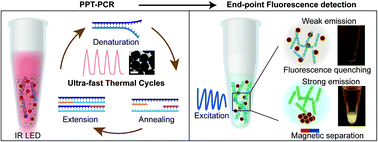A rapid and sensitive fluorescence biosensor based on plasmonic PCR†
Abstract
Plasmonic PCR utilizing metallic nanoparticles has shown great advantages compared to the commercial thermocycler equipment in terms of cost, size and processing time. However, due to the strong fluorescence quenching, plasmonic nanoparticle-based PCR requires additional post-processing steps such as centrifugation and gel electrophoresis. This process increases the overall diagnostic time, offsetting the benefits of fast thermocycling. Here, we report a rapid and sensitive plasmonic photothermal PCR (PPT-PCR) assay method based on in situ end-point fluorescence detection. By using plasmonic magnetic bi-functional nanoparticles, PPT-PCR involving 30 thermocycles and fluorescence detection following magnetic separation has successfully shown that DNA targets can be detected within 5.5 minutes. The limit of detection (3.3 copies per μL) is comparable with that of the conventional real-time quantitative PCR; however, the assay time is about 5.5 times shorter for the PPT-PCR. The strategy of combining the photothermal effect and magnetic separation into a single particle will open new horizons in the development of fast and sensitive PCR-based biosensors for point-of care testing.



 Please wait while we load your content...
Please wait while we load your content...